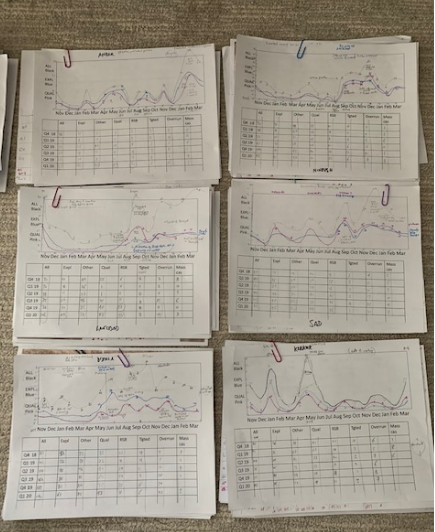See my new @CTCWP piece with @AlexMello02, which "cuts" 18 months of ISIS attack data from Iraq (Q4 2018 to Q1 2020 inclusive) to underline a strong, sustained recovery across a wider number of locations and with improved tactical leadership & bomb-making https://ctc.usma.edu/remaining-and-expanding-the-recovery-of-islamic-state-operations-in-iraq-in-2019-2020/">https://ctc.usma.edu/remaining...
First thing to say is a big thank you to @CruickshankPaul and the @CTCWP crew. This thing is 13k> words, three custom maps, three graphs and two tables. Fantastic job. As ever, a delight working with you guys.
This piece dovetails with the Dec 2018 study ( https://ctc.usma.edu/islamic-state-inside-iraq-losing-power-preserving-strength/),">https://ctc.usma.edu/islamic-s... which itself dovetailed with the Aug 2017 study of Iraq& #39;s next Sunni insurgencies https://ctc.usma.edu/predicting-the-shape-of-iraqs-next-sunni-insurgencies/">https://ctc.usma.edu/predictin... and Oct 2016& #39;s piece on Diyala https://ctc.usma.edu/losing-mosul-regenerating-in-diyala-how-the-islamic-state-could-exploit-iraqs-sectarian-tinderbox/">https://ctc.usma.edu/losing-mo... Read them as a collection for some context.
The piece does a really grainy look at over 3,600 assessed and geolocated ISIS attacks in Iraq in the last six quarters, after subjecting a larger dataset to a stringent scrape to remove possible non-ISIS incidents. The methodology is laid out in excruciating detail in footnotes.
Speaking of methodology, welcome to the world of pen and paper, hand-drawn maps, intense Google Earth peering and comparing to old datasets from prior eras, the genealogy and DNA of Iraq& #39;s insurgencies.
When I did the Dec 2018 cut of ISIS attack data in 2017-2018, I was surprised to see a significant downturn. I wondered if we were looking at deliberate withholding of effort / preservation of forces, or perhaps just a draining of enemy forces to Syria. In 2019, this changed.
Recovering from a new dip in Q1 2019, the story of ISIS in Iraq is one of unbroken recovery of attack capability and operational activity over the last year. There is strong evidence of an injection of talented tactical leaders and bomb-makers from Syria in early 2019.
The returning cadres, falling back on a patiently developed network of cave caches, got to work in H2 2019 and really began to generate steady, sustained growth in attacks across Diyala, Salah al-Din, west rural Baghdad and eventually even the lower Anbar Euphrates River Valley.
Getting very granular on attack data is very useful for spotting migration of tactics, techniques and procedures (TTPs). As we went through the attack data methodically, month after month, one can see more advanced TTPs oozing down the ERV to west Baghdad, and then fanning out.
We always had a tiny subset of "complex attacks" that combined attack types for "more than the sum of the parts" effectiveness, but those CPX attacks are now proliferating qualitatively, quantitatively and across more geographies. What do they look like? ...
Sniper or IED covers baseplate patrol/EOD/QRF/first responder.
Use of anti-civilian attack or arson to draw in actual tgts.
Feigned tactical retreat to draw pursuers onto IED/ambush.
Booby-trapped bodies.
Plus the whacky stuff: cow-borne IEDs ...
Use of anti-civilian attack or arson to draw in actual tgts.
Feigned tactical retreat to draw pursuers onto IED/ambush.
Booby-trapped bodies.
Plus the whacky stuff: cow-borne IEDs ...
In briefing out our findings to multiple agencies from multiple CJTF countries, there& #39;s sometimes pushback about whether ISIS is throwing more "quality attacks" - I think there& #39;s a definitional problem with how Western militaries view ISIS attack activities ...
Western militaries care about external operations plotting, urban mass casualty attacks & capabilities that could pose a risk to the premium force protection of NATO-standard force. But ISIS is not choosing to do any of these things: it is doing fit-for-purpose rural insurgency.
A radio-controlled surface-laid IED of 2x 60mm mortar rounds is more than lethal enough to kill most passengers in a PMF Hilux or a Fed Pol pickup, who lack route clearance, uparmoring, personal protective equipment, combat lifesaving and medevac. It is a high-quality attack.
Do enough successful roadside IEDs and overruns of checkpoints and village guard leaders, you begin to roll back the state& #39;s security forces from your bastions, and you create no-go zones. Inside those areas, you tax and recruit at will, because you are the state.
ISIS likes depopulated areas, hopefully with hard-to-penetrate physical terrain, in which they are the only occupants. Often anticlines, they border a lot of attack, extortion and logistical locations that are within range of a trail-bike raid and back in one period of darkness.
I think there& #39;s a significant correlation also between where ISIS likes operating, and where the coalition cannot do advise/assist/accompany/enable to the ISF. If you are ISIS, having the Iraqi militias preventing CJTF access is like having an umbrella overhead.
Conversely, where CJTF/CJSOTF & ISF/ISOF/tribes worked together, notably Kirkuk, we see progress. ISIS moves away from such areas like a cockroach fleeing the light. Logically, if everywhere had good CJTF/Iraq cooperation, ISIS would have nowhere to go.
The Baghdad-Kurdistan front line is studded with locations that are neither secured by federal forces nor the KR. These creases/seams need to be filled by better cooperation and the deployment of mutually trusted forces (high quality like ISOF, locally recruited for hold tasks).

 Read on Twitter
Read on Twitter


